Chemical profiles of Robusta and Arabica coffee by ESI(−)FT-ICR MS and ATR-FTIR: a quantitative approach†
Abstract
This paper reports a method to quantify Robusta coffee in Arabica coffee blends using univariate and multivariate models. Coffee samples were analyzed by negative-ion mode electrospray ionization Fourier transform ion cyclotron resonance mass spectrometry (ESI(−)FT-ICR MS) and by attenuated total reflection Fourier transform spectroscopy in the mid-infrared region (ATR-FTIR). To build the univariate calibration model with ESI(−)FT-ICR MS data, 12 samples of Arabica coffee adulterated with different proportions of Robusta coffee and doped with an internal standard were used. For the ATR-FTIR analysis, a higher variability of adulteration was employed with a total of 23 blend samples, and a partial least squares (PLS) regression model was proposed. The obtained univariate calibration model had limits of detection (LOD) and quantification (LOQ) of 0.2 and 0.3 wt%, respectively, whereas the PLS model with ATR-FTIR data had LOD and LOQ values of 1.3 and 4.3 wt%. Repeatability and intermediate precision for the ESI(−)FT-ICR MS model were 4 wt% and 5 wt%, respectively, and for the model with ATR-FTIR data both were 1.7 wt%. The proposed methodologies also enable the prediction of Robusta coffee adulteration in Arabica coffee commercial samples.


 Please wait while we load your content...
Please wait while we load your content...